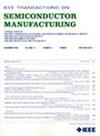Energy Consumption and Carbon Emission Reduction in HVAC System of a Dynamic Random Access Memory (DRAM) Semiconductor Fabrication Plant (fab)
IF 2.3
3区 工程技术
Q2 ENGINEERING, ELECTRICAL & ELECTRONIC
引用次数: 0
Abstract
This study focuses on energy saving for a Taiwan high-tech DRAM factory as the primary research subject. Collecting operational parameters related to various facility systems and process equipment is initially performed by using the developed energy conversion factors (ECF) calculator. Moreover, innovative fab energy simulation (FES) software has been designed by Taipei Tech. This software is designed for high-tech fab energy consumption analysis. The annual energy consumption data for fabs can be calculated. This data is then converted into carbon dioxide emissions using the power carbon emission coefficient provided by the Bureau of Energy, Ministry of Economic Affairs Taiwan. In this study, five different energy-saving strategies were proposed. The energy consumption and carbon emissions distribution were evaluated to assess the benefits of those different techniques. The findings show that among the existing operational facilities, the use of an exhaust air conditioning unit with reduced enthalpy value setting, with lowered supply air temperature, demonstrates the highest energy-saving. This technique has the potential to annually reduce carbon emissions by approximately 623,158 kg CO2 and operational costs by NT动态随机存取存储器(DRAM)半导体制造厂(fab)暖通空调系统的能源消耗与碳减排
本研究以台湾一家高科技 DRAM 工厂的节能为主要研究对象。首先使用已开发的能源转换系数(ECF)计算器收集与各种设施系统和工艺设备相关的运行参数。此外,台北科技大学还设计了创新的工厂能源模拟(FES)软件。该软件专为高科技工厂能耗分析而设计。它可以计算出工厂的年度能耗数据。然后,利用台湾经济部能源局提供的电力碳排放系数,将这些数据转换为二氧化碳排放量。本研究提出了五种不同的节能策略。对能源消耗和碳排放分布进行了评估,以评估这些不同技术的效益。研究结果表明,在现有的运行设施中,使用降低焓值设置的排风空调机,同时降低送风温度,节能效果最好。这项技术每年可减少约 623,158 千克二氧化碳排放,减少运营成本 6,005,764 新台币(189,602 美元)。这可以降低总体制造成本,同时也有利于环境。
本文章由计算机程序翻译,如有差异,请以英文原文为准。
求助全文
约1分钟内获得全文
求助全文
来源期刊

IEEE Transactions on Semiconductor Manufacturing
工程技术-工程:电子与电气
CiteScore
5.20
自引率
11.10%
发文量
101
审稿时长
3.3 months
期刊介绍:
The IEEE Transactions on Semiconductor Manufacturing addresses the challenging problems of manufacturing complex microelectronic components, especially very large scale integrated circuits (VLSI). Manufacturing these products requires precision micropatterning, precise control of materials properties, ultraclean work environments, and complex interactions of chemical, physical, electrical and mechanical processes.
 求助内容:
求助内容: 应助结果提醒方式:
应助结果提醒方式:


